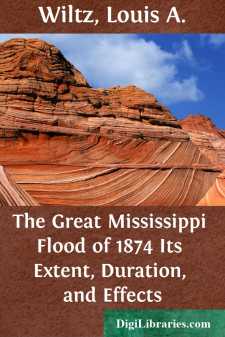Categories
- Antiques & Collectibles 13
- Architecture 36
- Art 48
- Bibles 22
- Biography & Autobiography 813
- Body, Mind & Spirit 142
- Business & Economics 28
- Children's Books 15
- Children's Fiction 12
- Computers 4
- Cooking 94
- Crafts & Hobbies 4
- Drama 346
- Education 46
- Family & Relationships 57
- Fiction 11828
- Games 19
- Gardening 17
- Health & Fitness 34
- History 1377
- House & Home 1
- Humor 147
- Juvenile Fiction 1873
- Juvenile Nonfiction 202
- Language Arts & Disciplines 88
- Law 16
- Literary Collections 686
- Literary Criticism 179
- Mathematics 13
- Medical 41
- Music 40
- Nature 179
- Non-Classifiable 1768
- Performing Arts 7
- Periodicals 1453
- Philosophy 64
- Photography 2
- Poetry 896
- Political Science 203
- Psychology 42
- Reference 154
- Religion 513
- Science 126
- Self-Help 84
- Social Science 81
- Sports & Recreation 34
- Study Aids 3
- Technology & Engineering 59
- Transportation 23
- Travel 463
- True Crime 29
The Great Mississippi Flood of 1874 Its Extent, Duration, and Effects
by: Louis A. Wiltz
Description:
Excerpt
MAYORALTY OF NEW ORLEANS.
NEW ORLEANS, May 30th, 1874.
On the 25th instant, the kind favor of the Western Union Telegraph Company enabled me to send to the Mayors of thirty-four large American cities the following dispatch:
“By request of Relief Committee and leading citizens, I again call on American in behalf of fifty-four thousand victims of the great flood, for such aid as your prosperity may permit or your philanthropy prompt you to grant. Contributions in cash and provisions in thirty-five days have been less than one hundred and eighty thousand dollars. In fifteen days our means will be exhausted. The demand for relief will continue great and urgent for many weeks. Daily rations have been distributed to about forty-five thousand—eight thousand furnished by the Government. Painful anxiety as to the results is general.
“Nothing but large increase of resources for relief can prevent the horrors of famine and great loss of life. We need a million of dollars more. Details will be given by mail.
LOUIS A. WILTZ,
Mayor and Treasurer of Relief Fund.”
To give the information promised, to extend the appeal to many other cites and to towns and corporate institutions, to enlist the aid of journalists and to lay before the members of the national legislature a statement of facts for their guidance, I issue this circular, with the hope that the great and increasing distress and danger in which the inhabitants of the overflowed regions now are may thus be made more widely known and the situation better understood.
The Mississippi River in average high water from Memphis to the Gulf is confined by artificial banks or levees to a channel, varying from half a mile to a mile in width. But for these embankments the unparalleled flood of this year would have formed, for all this distance, a continuous lake, covering the whole alluvial country, from twenty-five miles to one hundred and seventy-five miles in width, and more than six hundred miles long. But in spite of these levees, considerably more than one-half of this area has been submerged. The levees could not withstand the Mississippi in its mighty and ruthless violence, and they gave way in numerous crevasses, varying from one hundred to five thousand feet in width, aggregating fully six miles. Through these great chasms the flood has been pouring since the 15th April, in a stream seven feet in average depth and at the rate of more than seven miles an hour. More water is even now flowing from the great river over the farms and plantations of Arkansas, Mississippi and Louisiana, than falls over Niagara. This outflow must continue until the river recedes below its natural banks, an indefinite period. In some years high water has lasted a long time. In 1858 the river remained at its maximum 87 days and in 1859 at Vicksburg, 129 days. The flood of 1874, is higher than either, or than any on record.
The vast area of the overflow is estimated as follows by Wm. J. McCulloh, Esq.: formerly and for many years United States Surveyor General for Louisiana, a practical engineer and especially familiar with the inundated districts....


